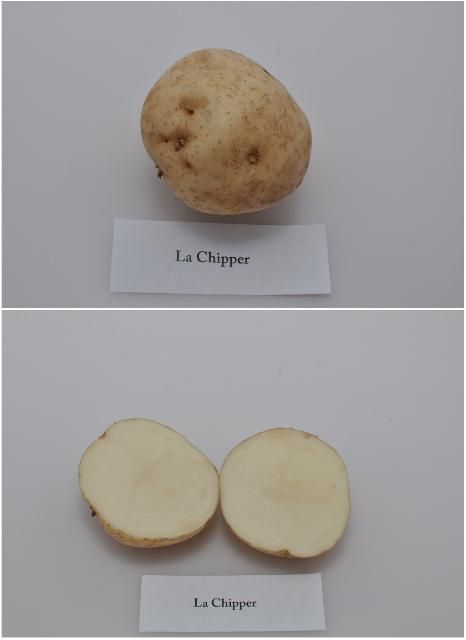University of Florida Potato Variety Trials Spotlight: 'LaChipper'1
There are several potato varieties available in the market today. Most of them have been bred or developed in production regions other than Florida. The University of Florida Potato Variety Evaluation Program screens new germplasm from public and private breeding programs and identifies the most promising cultivars for commercial potential considering broad adaptability to Florida climate and conditions and market purpose: processing, fresh-market and specialty-type varieties. Over the years, the UF/IFAS Potato Variety Program has become an important reference to vegetable growers, seed producers, processors, crop insurance agencies, and brokers looking for alternative potato varieties to explore different markets, improved characteristics, and yield. This UF/Potato Variety Trials Spotlight presents a summary of the field evaluation of tuber yield and quality performance of the potato variety `LaChipper' cultivated in Florida.
General Comments
'LaChipper' is a potato variety that is commonly grown for the fresh potato market in Florida. Under different growing conditions, 'LaChipper' is suited for chip processing. It was selected from progeny of a cross between Green Mountain and Cayuga and tested under the pedigree L91-78. It was released by the Department of Horticulture and Landscape Architecture, Louisiana Agricultural Experiment Station, Baton Rouge, LA in October of 1962. 'LaChipper' demonstrates high yield and good tuber characteristics compared to the commercial standard 'Atlantic'. Tuber production and quality results provided in this spotlight are from Florida Potato Variety Trials conducted at the UF/IFAS Hastings Agricultural Extension Center between 1998 and 2016.
General Characteristics
'LaChipper' tubers are moderately smooth with a round to oblong shape (Figure 1). According to Florida's rating codes for potato tuber characteristics (Table 1), the tubers have a fair to good appearance with buff skin color, white flesh, and deep to intermediate eye depth. On average, the marketable yield is 256 cwt/acre, approximately 12% less than the commercial standard 'Atlantic', with 83% of the tubers produced found between A1 and A3 tuber size classifications (Table 2).

Credit: Lincoln Zotarelli, UF/IFAS
Season Length and Growth
'LaChipper' is a medium-maturing cultivar under Florida growing conditions. Season length is 95 days on average from planting to harvest. This depends on weather conditions during the growing season. The plants should be harvested two to three weeks after vine kill to improve tuber maturation and skin set. Potatoes with proper skin set maintain better skin color, lose less weight in storage, and are more resistant to bruising and soft rot. For more information about vine killing on potatoes, see Potato Vine Killing or Desiccation (Zotarelli et al. 2016). Late in the season, tuber size should be checked regularly to harvest tubers with desirable marketable size. Soil moisture should be managed late in the season to avoid high soil moisture conditions that cause enlarged lenticels and delayed skin set.
Diseases
'LaChipper' demonstrates low incidence of hollow heart (1%) and corky ring spot (2%) under Florida conditions (Table 3). It has some resistance to late blight (Phytophthora infestans) and is moderately susceptible to common scab (Streptomyces scabies). Exposure to air pollution can result in defoliation and reduction in tuber yield.
The standard UF/IFAS Extension recommended disease and weed control program described under Potato Production (Chapter 14 of the Vegetable Production Handbook for Florida, https://edis.ifas.ufl.edu/cv131) should be followed.
Fertilization
UF/IFAS trial plots are normally fertilized with 200 to 230 lb/ac of N. The first application of 100 lb/ac of N (granular) is typically incorporated in the bed prior to planting, followed by one or two side-dress fertilizer applications at emergence and/or at tuber initiation. Phosphorus and potassium applications follow UF/IFAS guidelines described in Liu et al. (2020) and normally range between 45 to 100 lb/ac of P2O5 and 170 to 235 lb/ac of K2O.
Planting
A seed piece of 2.5 to 3 oz is recommended for planting. The crop should be planted with 40 inches between rows and 8 inches between plants, at 3 to 4 inches deep. A seed rate of 2,000 to 3,000 lb/acre of seed is expected.
Other Information
For additional information on cultivation and weed and disease management, see the Potato Production chapter of the Vegetable Production Handbook, available at https://edis.ifas.ufl.edu/cv131.
References
Hutchinson, C. M., J. M. White, D. M., Gergela, P. A. Solano, K. G. Haynes, R. Wenrich, and C. S. Lippi. 2003. "Performance of chip processing potato varieties in northeastern Florida." HortTechnology 13 (4): 706–711. https://doi.org/10.21273/HORTTECH.13.4.0706
Liu, G., E. H. Simonne, K. T. Morgan, G. J. Hochmuth, S. Agehara, and R. Mylavarapu. 2020. Chapter 2. Fertilizer Management for Vegetable Production in Florida. Vegetable Production Handbook for Florida, 2020–2021 Edition. CV296. Gainesville: University of Florida Institute of Food and Agricultural Sciences. https://edis.ifas.ufl.edu/cv296
Miller, Julian C., James F. Fontenot, and W. A. Young. 1963. "LaRouge and LaChipper two new potato varieties released by Louisiana." American Potato Journal 40 (4): 130–132. https://doi.org/10.21273/HORTTECH.13.4.0706
Sisson, J. A., and G. A. Porter. 2002. "Performance evaluations of potato clones and varieties in the northeastern states—1999." Maine Agr. For. Expt. Sta., Misc. Publ. 751.
Zotarelli, L., P. J. Dittmar, P. D. Roberts, J. Desaegar, and B. Wells.. 2020. Chapter 14. Potato Production. Vegetable Production Handbook for Florida, 2020–2011 Edition. HS733. Gainesville: University of Florida Institute of Food and Agricultural Sciences. https://edis.ifas.ufl.edu/cv131
Zotarelli, L., S. Sargent, P. Dittmar, and M. Makani. 2016. Potato Vine Killing or Desiccation. HS181. Gainesville: University of Florida Institute of Food and Agricultural Sciences. https://edis.ifas.ufl.edu/hs181
Tables
Summary of production statistics and specific gravity of 'LaChipper' potato variety grown at the UF/IFAS Hastings Agricultural Extension Center, Hastings, FL from 1998 to 2016.


